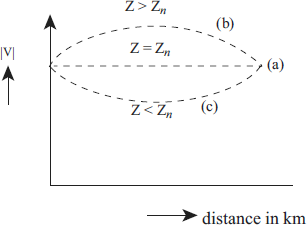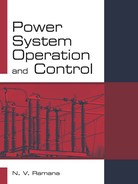8.6 NECESSITY FOR REACTIVE POWER COMPENSATION IN A TRANSMISSION LINE
As explanined in Section 8.4, the voltage profile varies with distance along the transmission line. Power system engineers will be happy it they are able to maintain a flat voltage profile throughout the distance of the transmission line, which is the ideal case.

Fig 8.6 Voltage variation over a transmission line.
Power system research engineers have worked for several decades to develop compensation techniques for transmission line, which can maintain the voltage profile close to the ideal case. These compensations are essential because, if the voltage in the system is boosted up due to heavy injection of reactive power, it will lead to an increase in load with drop in frequency causing system collapse. On the other hand, if the voltage in the system decreases due to low reactive power injection in the line, it leads to voltage collapse.
Every transmission line has its own limitations, namely, thermal limit and stability limit.
The thermal limit of a transmission line depends upon the ambient temperature, nature of wind and the current flowing in the conductor. Beyond a certain limit, it is not possible to operate the transmission line since it will damage the conductor.
The stability limit of a transmission line includes steady state stability limit, transient stability limit, dynamic stability limit and voltage stability limit.
Hence compensation in a transmission line is very essential in order to maintain these limitations within strict limits for satisfactory operation and overall system performance.
